The TLC: a novel auditory nucleus of the mammalian brain
- PMID: 18045905
- PMCID: PMC6673411
- DOI: 10.1523/JNEUROSCI.1892-07.2007
The TLC: a novel auditory nucleus of the mammalian brain
Abstract
We have identified a novel nucleus of the mammalian brain and termed it the tectal longitudinal column (TLC). Basic histologic stains, tract-tracing techniques and three-dimensional reconstructions reveal that the rat TLC is a narrow, elongated structure spanning the midbrain tectum longitudinally. This paired nucleus is located close to the midline, immediately dorsal to the periaqueductal gray matter. It occupies what has traditionally been considered the most medial region of the deep superior colliculus and the most medial region of the inferior colliculus. The TLC differs from the neighboring nuclei of the superior and inferior colliculi and the periaqueductal gray by its distinct connections and cytoarchitecture. Extracellular electrophysiological recordings show that TLC neurons respond to auditory stimuli with physiologic properties that differ from those of neurons in the inferior or superior colliculi. We have identified the TLC in rodents, lagomorphs, carnivores, nonhuman primates, and humans, which indicates that the nucleus is conserved across mammals. The discovery of the TLC reveals an unexpected level of longitudinal organization in the mammalian tectum and raises questions as to the participation of this mesencephalic region in essential, yet completely unexplored, aspects of multisensory and/or sensorimotor integration.
Figures

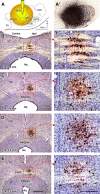
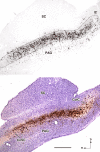
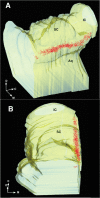
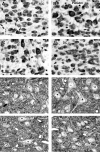

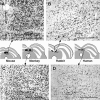
Similar articles
-
Connections of the Superior Paraolivary Nucleus of the Rat: II. Reciprocal Connections with the Tectal Longitudinal Column.Front Neuroanat. 2011 Feb 22;5:1. doi: 10.3389/fnana.2011.00001. eCollection 2011. Front Neuroanat. 2011. PMID: 21373368 Free PMC article.
-
The dorsal tectal longitudinal column (TLCd): a second longitudinal column in the paramedian region of the midbrain tectum.Brain Struct Funct. 2014 Mar;219(2):607-30. doi: 10.1007/s00429-013-0522-x. Epub 2013 Mar 7. Brain Struct Funct. 2014. PMID: 23468089 Free PMC article.
-
Projections from the inferior colliculus to the tectal longitudinal column in the rat.Neuroscience. 2010 Mar 17;166(2):653-64. doi: 10.1016/j.neuroscience.2009.12.074. Epub 2010 Jan 6. Neuroscience. 2010. PMID: 20056139
-
Neuroanatomical approaches of the tectum-reticular pathways and immunohistochemical evidence for serotonin-positive perikarya on neuronal substrates of the superior colliculus and periaqueductal gray matter involved in the elaboration of the defensive behavior and fear-induced analgesia.Exp Neurol. 2006 Jan;197(1):93-112. doi: 10.1016/j.expneurol.2005.08.022. Epub 2005 Nov 21. Exp Neurol. 2006. PMID: 16303128
-
Neural substrate of defensive behavior in the midbrain tectum.Neurosci Biobehav Rev. 1994 Fall;18(3):339-46. doi: 10.1016/0149-7634(94)90047-7. Neurosci Biobehav Rev. 1994. PMID: 7984352 Review.
Cited by
-
Auditory response properties of neurons in the tectal longitudinal column of the rat.Hear Res. 2008 Oct;244(1-2):35-44. doi: 10.1016/j.heares.2008.07.001. Epub 2008 Jul 12. Hear Res. 2008. PMID: 18662764 Free PMC article.
-
All the way from the cortex: a review of auditory corticosubcollicular pathways.Cerebellum. 2015 Oct;14(5):584-96. doi: 10.1007/s12311-015-0694-4. Cerebellum. 2015. PMID: 26142291 Review.
-
Auditory thalamic circuits and GABAA receptor function: Putative mechanisms in tinnitus pathology.Hear Res. 2017 Jun;349:197-207. doi: 10.1016/j.heares.2016.08.009. Epub 2016 Aug 21. Hear Res. 2017. PMID: 27553899 Free PMC article. Review.
-
Survey of Midbrain, Diencephalon, and Hypothalamus Neuroanatomic Terms Whose Prosomeric Definition Conflicts With Columnar Tradition.Front Neuroanat. 2019 Feb 27;13:20. doi: 10.3389/fnana.2019.00020. eCollection 2019. Front Neuroanat. 2019. PMID: 30873012 Free PMC article. Review.
-
Connections of the Superior Paraolivary Nucleus of the Rat: II. Reciprocal Connections with the Tectal Longitudinal Column.Front Neuroanat. 2011 Feb 22;5:1. doi: 10.3389/fnana.2011.00001. eCollection 2011. Front Neuroanat. 2011. PMID: 21373368 Free PMC article.
References
-
- Aitkin L. Clifton, NJ: Humana; 1986. The auditory midbrain: structure and function in the central auditory pathway.
-
- Behan M, Kime NM. Spatial distribution of tectotectal connections in the cat. Prog Brain Res. 1996;112:131–142. - PubMed
-
- Behbehani MM. Functional characteristics of the midbrain periaqueductal gray. Prog Neurobiol. 1995;46:575–605. - PubMed
-
- Beitz AJ, Shepard RD. The midbrain periaqueductal gray in the rat. II. A Golgi analysis. J Comp Neurol. 1985;237:460–475. - PubMed
-
- Berman AL. Madison, WI: University of Wisconsin; 1968. The brain stem of the cat: a cytoarchitectonic atlas with stereotaxic coordinates.
Publication types
MeSH terms
Substances
Grants and funding
LinkOut - more resources
Full Text Sources
